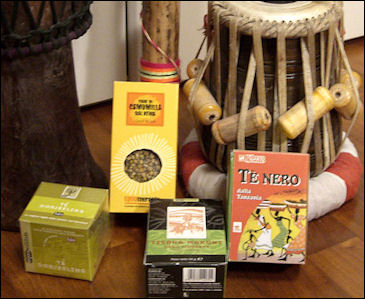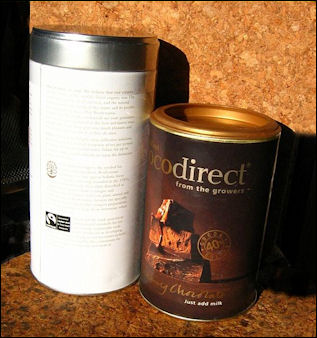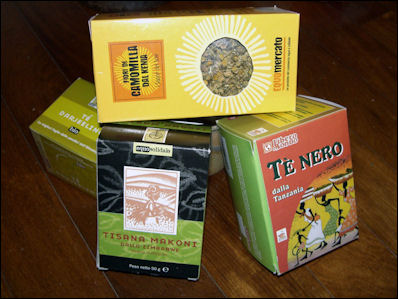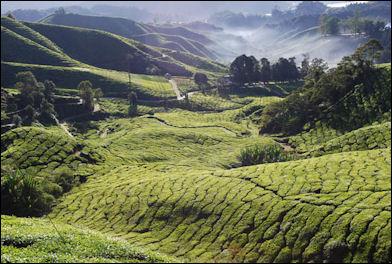FAIR TRADE

Fair Trade Products A number of charities, NGOs and other organizations have embraced the fair trade issue. The fair trade concept was pioneered and is largely overseen by the World Fair Trade Association (WFTO). Fair Trade aims to ensure that the farmers and producers, who are the sources of the products sold under the Fair Trade label, earn a fair wage, work in healthy conditions and women are treated equally. The WFTO has quickly grown from a relatively small non-governmental organization into a global enterprise with 21 international branches under the umbrella of the Fairtrade Labeling Organization ( FLO) as of early 2009. FLO sets the standards for certifications. Farms, estates, plantations and other enterprises are checked and certificates are awarded by FLO-CERT, which FLO says is independent but in fact is wholly-owned by WFTO.
A Fairtrade spokesman told the Times of London, “Before becoming Fairtrade-certified, estates need to demonstrate that they meet Fairtrade standards to pay decent wages, guarantee the right to join a trade union, ensure health and safety standards and provide adequate housing and other social provision where relevant.”
Fairtrade certification allows a producer to sell its products labeled as Fairtrade but it is up to wholesalers to decide whether to buy the product as Fairtrade or more cheaply as a standard product without the label. Fairtrade-certified producers can purchase product from non-certified producers where the conditions for workers can be quite poor but can not sell the product as fair trade.
Fair Trade and ECO-O.K. Coffees
These days many companies have begun promoting "ECO-O.K." coffees whose designation is based on the amount of shade trees used to grow the coffee, respect for the rain forest, the use of fertilizers and pesticides, wages given to peasants and the environmental-soundness of the mills. Few growers score A+'s in all categories but those that meet most of them get the "ECO-O.K" designation. Only about a sixth of the coffee consumed by Americans is grown organically in the shade.
Fair Trade is a network of North American and European activist who act as middle men and pay coffee growers higher than market prices for their crops and sell the beans to companies that sell their products at supermarkets with a " Fair Trade" label for $2 more than regular coffee. Under the coffee industry’s Fair Trade protocol, farmers in 2003 were paid $1.26 a pound for beans, more double the current average price of 52 cents a pound for green coffee. Farmers who grow coffee for Fair-Trade- certified coops say their income has doubled.

Procter & Gamble sells a premium coffee called Millstone that has been certified by the protocol. Starbucks and Wall-Mart also sell Fair Trade coffees. As of 2004, Fair Trade coffee made up only 0.5 percent of the total coffee market. About 35 to 45 percent of the Fair Trade coffee sold in the United States is sold at Fair Trade prices. The rest is sold at market value in regular coffee.
Pauk Katzeff, a buddy of Hunter Thompson, is the leader of a movement to encourage farmers to grow high quality arabica beans. The idea is that high quality coffee will bring in higher prices, helping the farmer, and protect the environment and rain forest by encouraging farmers to raise arabica beans that grow better shaded by other trees than cheap robusta beans that do better in open sun.
Groups such as Oxfam are trying to pressure the four big coffee roasters — Sara Lee, Nestle, Proctor & Gamble and Kraft — into guaranteeing that farmers get paid more than their production costs.
There is also a movement to produce organic coffee. Organic coffees have only a 1 percent share of the market and some think the idea is a dead end because people “don’t want to think about their health when they drink coffee.”
Criticism of Fair Trade
Some producers complain the Fairtrade system is too expensive to implement and some workers find it too restrictive. Critics complain the Fairtrade system is difficult to manage and benefits often don’t reach the workers they are intended to help. Some of them say Fairtrade has became a marketing ploy that factory and land owners manipulate do move their products. Workers that complain often complain about the caps on overtime which prevent them from making more money.
Tim Heinesmann, a Danish film maker who visited a number of tea estates for his documentary “The Bitter Taste of Tea” told the Times of London he found that workers at Fairtrade-labeled tea estates often saw few benefits from the labeling, “Workers got things like a gas cylinder, a Thermos flask or a laundry basket. But these would come after years of not getting anything,” he said.
Heinesmann added the Fairtrade inspections are announced in advance. “The estate owners can tell the workers not to be critical. It is a harsh system. [The workers] are deeply afraid of the owners because they can lose their job.” He said the estate owners are quite skilled at getting around the rules, for example , hiring workers for three months, firing them and rehiring them to get around regulations for full-time workers.
Paulo Ghliani, a former board member of FLO and the head an FLO-linked organization in Switzerland, told the Times of London, “The Fairtrade label has grown so fast but has forgotten to invest enough in growth management like normal companies. She said that Fairtrade member organizations sometimes feud over the way inspections are carried out and has argued the fact that the FLO receives funding and money for license fees compromises the independence, professionalism, and credibility of the inspection process.
Is Fair-Trade Coffee Worse than Regular Beans?

Justin Moyer wrote in the Washington Post: Only 4 percent of gourmet or specialty coffee consumed in the United States is ethically produced fair-trade java, and some of it doesn’t taste that great.”Low consumer demand for Fair Trade coffee means that not all of a particular farmer’s coffee, which will be of varying quality, may be sold at the Fair Trade price,” Colleen Haight writes in “The Problem With Fair Trade Coffee,” an article in the summer 2011 issue of the Stanford Social Innovation Review. “To maximize his income, therefore, he will choose to sell his lower quality coffee as Fair Trade coffee,” while letting the good stuff fetch even higher prices than the fair-trade price floor. [Source: Justin Moyer, Washington Post, August 5, 2011]
And there’s worse news for high-minded caffeine junkies scrutinizing labels at Whole Foods. Even though coffee prices are five times higher than they were 10 years ago, buying sometimes bitter-tasting, expensive fair-trade beans may not help reduce poverty. “The primary focus and beneficiary [of fair trade] is the small farmer, who, in turn, is defined as a small landowner,” Haight writes. “The poorest segment of the farming community, however, is the migrant laborer who does not have the resources to own land and thus cannot be part of a [fair-trade] cooperative.”
Is there an alternate way for concerned coffee consumers to do good yet get a decent latte? They should trust their local coffee shop, Haight says. “Some big coffee retailers want to stop relying on fair-trade labeling organizations and start developing their own sense of what’s equitable. Starbucks has “a C.A.F.E. [Coffee and Farmer Equity] Practice — a program that defines socially responsible business guidelines for their buyers,” she writes. “Many coffee producers have taken note of this model and made their practices more sustainable to attract the attention of Starbucks’ buyers.” Agent Cooper would probably raise a mug or two to that.
Workers at Fair-Trade-Certified Tea Estates
Dunsandle is a tea estate in the Niligiri Hills of south-central India that been received Fairtrade certification since 2000. Workers at the estate that talked to the Times of London were quick to criticize the designation or had never heard of it. One said, “No matter what the propaganda [related to Fair-trade] is in Europe, nothing is being done here to help us.” Another said, “If there is extra money, we have no idea what is happening to it. We requested help to buy gas or a bus to take the children to school. There was talk of a community center being built, but nothing has happened.” One of the problems with Dunsandle is that only a small percentage of the tea sold by the estate is Fairtrade.” The workers earn a basic wage of $1.76 a day. Much of the money from the Fairtrade premiums have gone into a retirement bond scheme that its beneficiaries don’t understand.
Kitumbe is a Fair-trade-certified tea estate, owned by the international tea conglomerate Finlay’s, near the Great Rift Valley in Kenya. Workers there live three or four to a room in one room shacks with leaky roofs. The Times of London reported managers at the estate were given ample warning that the FLO inspectors were coming. Before they arrived huts were painted and workers were coached what t say. A report by Kenya Human Rights said that sexual harassment and the mistreatment of workers was common at tea estates owned by Finlay’s. The organization said workers were often hired based on their ethnicity and housing was “deplorable.” There, workers are paid about 42 cents a day.
Fair-Trade-Certified Tea Estates and Coffee

tea plantation in Malaysia Parminder Bahra wrote in Times of London, “In the tea market, Fairtarde is taking on an industry that for decades has been accused of exploiting its workers. The task is complicated because most workers are hired by tea estates that have hardly changed in a century. Estates are run as small kingdoms, with worker’s accommodation supplied by the company...In tea estates, the premium is initially held by the estate owners. Under Fairtrade rules, the estates must set up a joint body of managers and workers who decide how the premium is spent. In many instances that does not happen.”
The system works much better with coffee. Bahra wrote in Times of London, “In the coffee industry, the relationship between the farmer or worker, and the premium is much closer. Fair-trade certifies only small-scale farmers (or co-cooperatives) and the Fairtrade premium paid by coffee buyers goes directly to the farmers or cooperative.
In the tea industry Bahra, wrote, “Inspections are vital to ensure that poor practices are tallied, but there remains a nagging doubt as to whether they are sufficiently robust when the labeling scheme, standards and inspections are all run by the same organization. Fairtrade admits that some workers have not heard of Fairtrade but argues that it takes time to educate and involve the workers. But consumers have a right to known that there are problems in the tea industry and that the situation is not as rosy as some of the marketing suggests.”
Image Sources: Wikimedia Commons
Text Sources: New York Times, Washington Post, Los Angeles Times, Times of London, Yomiuri Shimbun, The Guardian, National Geographic, The New Yorker, Time, Newsweek, Reuters, AP, Lonely Planet Guides, Compton’s Encyclopedia and various books and other publications.
Last updated January 2012
